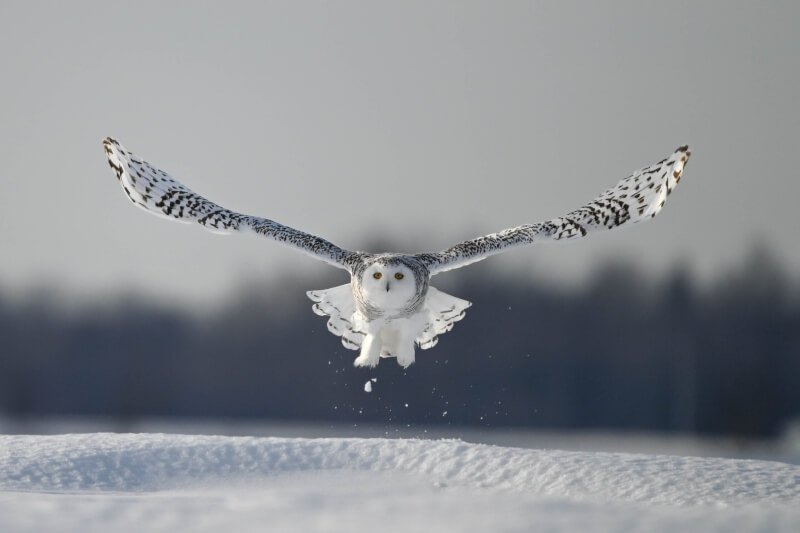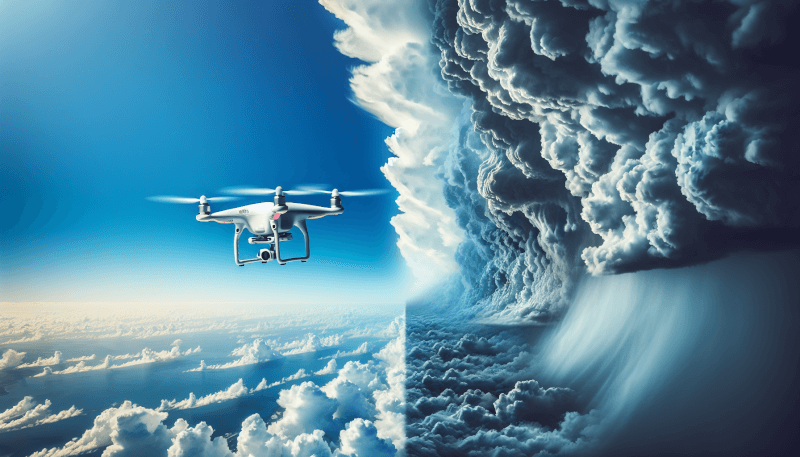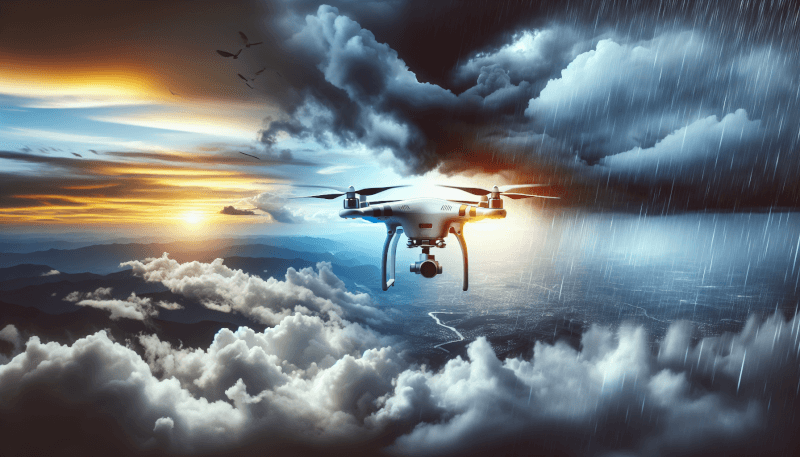Flying drones in different weather conditions requires careful consideration of several key factors. From rain and wind to extreme heat or cold, each weather condition presents unique challenges that drone operators must be aware of. Factors such as battery life, stability, visibility, and flight restrictions become even more important in inclement weather. This article explores these key factors to help you navigate the skies with your drone safely and effectively, regardless of the weather conditions.

Wind
Impact of wind on drone stability
When flying a drone, it is important to consider the impact of wind on its stability. Strong winds can significantly affect a drone’s ability to maintain its position and stability in the air. The force of the wind can cause the drone to drift or even be blown away, making it difficult to control. This can lead to crashes, damage to the drone, or even loss of the drone altogether.
Maximum wind speed for safe flying
To ensure safe flying conditions, it is essential to know the maximum wind speed that a drone can handle. Each drone model has its own specific limitations when it comes to wind speed. Generally, consumer drones can handle wind speeds of around 10-20 miles per hour, while professional drones may be able to withstand higher wind speeds. It is crucial to check the manufacturer’s specifications and guidelines to determine the maximum wind speed for safe flying.
Techniques to handle windy conditions
When flying a drone in windy conditions, there are several techniques that can help maintain control and stability. One technique is to fly the drone against the wind, as this allows for better control and reduces the risk of the drone being carried away. Additionally, reducing the drone’s altitude can help mitigate the effects of strong winds. It is also advisable to avoid sudden movements or aggressive maneuvers, as these can further destabilize the drone. Lastly, monitoring wind speed and direction through weather apps or anemometers can provide valuable information to decide whether it is safe to fly the drone or not.
Temperature
Effects of temperature on drone performance
Temperature can have a significant impact on the performance of a drone. In extremely cold temperatures, the drone’s batteries can experience reduced efficiency and shortened flight times. Cold weather can also cause difficulties with the drone’s motors, as they may struggle to generate enough power to keep the drone airborne. On the other hand, high temperatures can lead to overheating of the drone’s components, potentially causing damage or even complete failure.
Operating limits in extreme temperatures
To ensure the safe operation of a drone, it is important to be aware of its operating limits in extreme temperatures. Most consumer drones have recommended temperature ranges for flying, typically between 32°F to 104°F (0°C to 40°C). Flying outside of these temperature ranges can lead to issues with battery performance, motor efficiency, and overall drone stability. It is essential to consult the drone’s user manual or manufacturer’s guidelines to determine the specific operating limits for a particular model.
Precautions in cold and hot weather
In cold weather, it is advisable to keep the drone’s batteries warm before flight to maintain their performance. This can be done by using battery warmers or storing them in a warm location. It is also important to avoid sudden temperature changes, such as bringing a cold drone indoors to a warm environment. This can cause condensation to form, potentially damaging the drone’s electronics.
In hot weather, it is crucial to avoid prolonged exposure of the drone to direct sunlight, as this can cause overheating. It is recommended to fly in the early morning or late afternoon when temperatures are lower. Additionally, providing shade for the drone during breaks or in between flights can help prevent overheating.
Rain
Impact of rain on drone components
Rain poses a significant risk to drone components, especially those that are not waterproof. Water can damage the drone’s motors, electrical connections, and other sensitive electronic components. Raindrops can also interfere with the drone’s sensors and potentially affect its ability to maintain stable flight.
Suitable weather conditions for flying in rain
Flying a drone in rain should generally be avoided unless the drone is specifically designed for waterproof operations. Waterproof drones have their electronic components protected and are equipped with sealed motors and connectors to resist water damage. However, even waterproof drones have limitations and should not be flown in heavy rain or during thunderstorms, as the combination of rain and strong winds can still pose risks.
Protective measures for flying in light rain
If you need to fly a non-waterproof drone in light rain, there are several protective measures that can be taken. Using a waterproof drone cover or a protective case can shield the drone from water exposure. Additionally, applying a hydrophobic coating to the drone’s body and electronic components can help repel water. It is essential to dry the drone thoroughly after flying in rain to prevent moisture buildup and potential damage.
Snow
Challenges of flying in snowy conditions
Flying a drone in snowy conditions presents unique challenges. The most significant challenge is the visibility impairment caused by falling snowflakes or snowstorms. Reduced visibility makes it difficult to accurately control the drone and may increase the risk of collisions. Snow can also accumulate on the drone’s body, propellers, and sensors, affecting its aerodynamics and overall performance.
Preventing damage to the drone in snow
To prevent damage to the drone in snow, it is advisable to avoid flying in heavy snowfall or blizzard-like conditions. Snow can infiltrate the drone’s sensitive components, leading to water damage and potential system failure. Before flying, it is important to brush off any snow accumulation on the drone to ensure unobstructed rotor movement and prevent imbalances. Keeping the drone’s motors and battery warm can also help maintain optimal performance in cold temperatures.
Considerations for capturing video in snow
Capturing video in snowy conditions can result in stunning footage, but it requires additional precautions. To ensure the best quality video, it is recommended to use a lens hood or a lens filter to minimize glare from the snow. Adjusting the camera’s exposure settings can also help properly capture the contrast between the snow and the surrounding landscape. It is important to keep the drone steady and avoid abrupt movements to ensure smooth and stable footage.

Fog
Visibility considerations in foggy conditions
Flying a drone in foggy conditions can be extremely challenging due to reduced visibility. Fog obstructs the pilot’s line of sight and makes it difficult to maintain orientation and avoid obstacles. It is crucial to have a reliable visual reference point, such as a spotter or a clear landmark, to ensure the drone stays within sight.
Effects of moisture on drone electronics
Moisture, including fog, can pose risks to the drone’s electronics. Water droplets in the air can condense on the drone’s body and components, potentially causing short circuits or damaging sensitive electronics. It is important to keep the drone dry and avoid prolonged exposure to foggy conditions to minimize the risk of moisture damage.
Guidelines for flying in fog
Flying a drone in fog should be approached with caution. It is recommended to fly at a lower altitude to maintain better visibility and reduce the risk of losing the drone in the fog. Using obstacle avoidance systems and GPS technology can help mitigate the risks associated with flying in foggy conditions. It is crucial to constantly monitor the drone’s position and maintain communication with the aircraft to ensure safe flight.
Thunderstorms
Avoiding lightning strikes
Flying a drone during a thunderstorm is highly dangerous due to the risk of lightning strikes. Drones act as conductors and can attract lightning, potentially leading to severe damage or complete destruction. It is essential to avoid flying a drone when there is a possibility of thunderstorms in the area. Monitoring weather forecasts and staying informed about local weather conditions can help in making informed decisions regarding flight.
Guidelines for flying during thunderstorms
Flying a drone during thunderstorms should be strictly avoided. Thunderstorms bring heavy rain, strong winds, and unstable atmospheric conditions, all of which can pose risks to the drone’s stability and performance. It is important to prioritize safety and wait until the storm has passed before operating the drone. Protecting the drone from exposure to heavy rain and strong winds is paramount to prevent damage or loss.
Preventing damage from heavy rain and strong winds
In the event of heavy rain and strong winds, it is crucial to take preventative measures to protect the drone. Seeking shelter indoors or using a waterproof cover can help shield the drone from rain. Additionally, finding a location shielded from strong winds, such as behind trees or buildings, can reduce the risk of the drone being blown away or losing control. It is essential to prioritize the safety of the drone and follow local regulations and guidelines regarding adverse weather conditions.

Sunlight
Effects of glare on drone operator
Glare from sunlight can significantly impact the drone operator’s ability to see the screen or monitor displaying the drone’s live video feed. The excessive brightness can make it difficult to accurately control the drone and may result in slower response times. Squinting or straining to see the screen for prolonged periods can also cause eye fatigue and discomfort.
Optimal flying conditions for sunny weather
Sunny weather provides optimal flying conditions for drones, as long as precautions are taken to mitigate glare and maintain visibility. Flying during the early morning or late afternoon can help reduce the intensity of sunlight and minimize glare. Choosing locations with shaded areas can also provide better visibility during sunny conditions.
Protection for drone camera and sensors
To protect the drone’s camera and sensors from excessive sunlight, it is advisable to use lens filters. Lens filters can reduce glare, enhance color balance, and improve the overall quality of the footage. Additionally, using a sunshade or a monitor hood can help shield the screen or monitor from direct sunlight, improving visibility and reducing eye strain for the operator.
Altitude
Effect of altitude on drone performance
Altitude can have a significant impact on drone performance, especially for drones that rely on air density for lift. As altitude increases, the air becomes less dense, resulting in reduced lift capabilities for the drone. This can affect the drone’s overall stability and performance, making it more difficult to control. The impact of altitude on drone performance varies depending on the specific model and its design.
Limitations at high altitudes
Operating a drone at high altitudes can present challenges due to the reduced air density. The reduced lift produced by the drone’s propellers may result in decreased maneuverability and limited payload capacity. It is important to be aware of the drone’s limitations at high altitudes and adjust flight plans accordingly. High-altitude flying may also be subject to specific regulations or restrictions set by local aviation authorities.
Adapting flight plan with changing altitude
When planning a flight that involves changing altitudes, it is crucial to consider the drone’s performance capabilities and limitations. Ascending or descending too rapidly can strain the drone’s motors and battery, potentially leading to overheating or premature failure. It is recommended to adjust the flight plan to allow for smooth and gradual changes in altitude, ensuring that the drone maintains stability and optimal performance.

Humidity
Impact of humidity on drone electronics
Humidity can impact drone electronics, particularly if there is prolonged exposure to high levels of moisture. Moisture can cause corrosion on electrical connections, leading to poor conductivity or even circuit malfunctions. High humidity levels can also promote condensation inside the drone, potentially damaging internal components.
Avoiding moisture damage
To avoid moisture damage, it is important to keep the drone dry and minimize exposure to high humidity conditions. Storing the drone in a dry and ventilated area when not in use can help prevent moisture buildup. Using silica gel packs or desiccants in the drone’s storage case can also help absorb excess moisture. After flying in humid conditions, it is essential to allow the drone to dry completely before storing it to prevent any residual moisture from causing damage.
Precautions to take in high humidity
In high humidity conditions, it is advisable to regularly inspect the drone for signs of moisture accumulation or corrosion. Wiping down the drone’s exterior with a soft cloth after flights in humid environments can help remove any moisture or condensation. Regular maintenance checks, including inspecting electrical connections and cleaning the drone’s sensors, can help prevent long-term damage caused by high humidity.
Visibility
Importance of visibility for drone operation
Visibility is crucial for safe drone operation. Maintaining clear visual contact with the drone is essential for ensuring its stability, avoiding obstacles, and complying with flight regulations. Poor visibility can increase the risk of collisions, loss of control, or violation of airspace restrictions. Maintaining an unobstructed line of sight between the operator and the drone is essential for safe and responsible flying.
Flying in low visibility conditions
Flying in low visibility conditions, such as heavy fog, smog, or darkness, should be approached with extreme caution. It is important to assess whether flying in such conditions is necessary or if it can be delayed until visibility improves. If low visibility flight is unavoidable, using visual aids such as bright LED lights on the drone can help enhance its visibility to the operator.
Using visual aids for better visibility
To improve visibility during low-light or low visibility conditions, several visual aids can be used. Installing bright LED lights on the drone itself can make it more visible from a distance. It is also important to equip the drone with navigation lights to indicate its orientation to other aircraft or observers. Additionally, using anti-collision lights or strobes can help enhance visibility and alert others to the presence of the drone.
In conclusion, flying a drone in different weather conditions requires careful consideration of various factors. Wind, temperature, rain, snow, fog, thunderstorms, sunlight, altitude, humidity, and visibility all play significant roles in drone operation. By understanding the impact of these weather conditions on drone stability, performance, and the risk they pose to drone components, operators can make informed decisions and take necessary precautions to ensure safe and successful flights.



